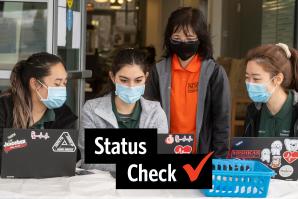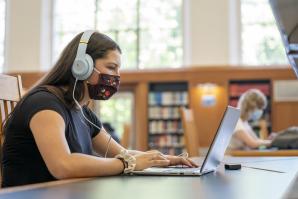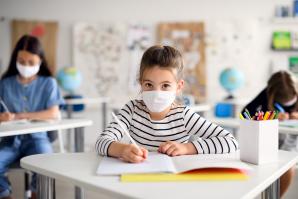This is no academic question: How are schools in the Sacramento region coping with the COVID-19 delta variant among students and staff? Our public health depends in no small part on how staff and students protect themselves and others from the deadly disease. Much hangs in the balance as the evolving nature of the pandemic and policies responding to that fluidity can change from day to day. Here is a rundown of mitigation efforts at some public school districts, colleges and universities in the Capital Region.
Sacramento City Unified School District
A message on the Sacramento City Unified School District’s website, which serves 83 schools, pledges to “continue to implement any and all measures recommended by public health leaders to protect the health and safety of our students, our staff, and our community throughout this public health emergency. Sac City Unified works in close consultation with Sacramento County Public Health and the Sacramento County Office of Education, and follows guidance from California Governor Gavin Newsom and the California Department of Public Health.” Those measures include social distancing and mandatory masking indoors regardless of vaccination status.
Another measure is no-cost and voluntary COVID-19 testing for all students and staff at school sites and the Serna Center, the district office. This measure, especially for children under the age of 12 who are unapproved for vaccinations, provides parents and guardians with vital information. The district also offers free COVID-19 vaccinations at the Serna Center.
“Overall, I think the district is doing a good job with their mitigation policies,” says John Zulli, whose son attends Sutter Middle School. “They have kept parents well informed, and it is apparent from their communication that the children’s and teachers’ health and safety is their first priority. I believe the district is taking the pandemic seriously and doing what they can in a very difficult and dynamic situation.”
“I believe the district is taking the pandemic seriously and doing what they can in a very difficult and dynamic situation.”
John Zulli, parent, Sutter Middle School
However, the Sacramento City Teachers Association has expressed dissatisfaction with the district’s mitigation efforts. David Fisher, who helms SCTA, says that SCUSD lacks distance learning options for students unable to attend in-person instruction, despite the independent study requirements outlined in Assembly Bill 130.
SCTA also filed a complaint related to the district’s response to an outbreak of COVID-19 at the New Joseph Bonnheim Community Charter School, which has about 270 students and began instruction August 9. The outbreak, infecting nearly 7 percent of students, over 33 percent of staff and 31 percent of teachers, began around August 10, according to a Cal/OSHA complaint that the SCTA filed Sept. 7. The district failed to “adequately investigate possible exposure,” such as through contact tracing, the complaint alleges. The district did not respond to a request for comment.
Los Rios Community College District
“Keeping our students and employees, and as a result their family and friends, safe and healthy is at the forefront of everything we are doing to respond to the COVID-19 pandemic,” says Gabe Ross, an associate vice chancellor with the Los Rios Community College District. “Earlier in August, the LRCCD — led by our Board of Trustees — announced a vaccination requirement for all students and employees by October 1, 2021.”
LRCCD students and staff may request a medical or religious exemption. In addition, each of the four LRCCD campuses (American River College, Cosumnes River College, Folsom Lake College and Sacramento City College) offer assistance with providing vaccination verification.
The use of masks to prevent the transmission of COVID-19, regardless of vaccination status, is in effect for all LRCCD staff and students at all four campuses. “This practice is consistent with the guidance from the Sacramento County Department of Public Health and other experts,” Ross says.
Sonia Ortiz-Mercado, the vice president of student services at Folsom Lake College, one of the four colleges in the district, says that the college installed air filtration and ventilation systems that are “equivalent to N95 mask protection” in the summer. “In case of a student infection, we have a notification process that begins with instructors and staff notifying the school administration which in turn contacts the LRCCD management,” she says, adding that LRCCD has in-house nurses who do contact tracing.
The district also offers up to $200 in incentives for students who can show proof of full vaccination. Olivia DeLeonardis, an animal science major at Sacramento City College, has mixed feelings about the incentives. “On one hand, I think it will work to motivate people to get vaccinated,” she says. “On the other hand, the LRCCD also could have used that money for low-income students to fund their education.”
Sacramento State
At Sacramento State, Education and Ethnic Studies Professor Margarita Berta-Avila heads the campus chapter of the California Faculty Association, the union that represents lecturers, professors, counselors, librarians and coaches throughout the 23-campus system. “We are meeting on a consistent basis with the school administration to ensure the safest environment for faculty and their students,” she says.
“It is important for there to be clarity and transparency with the administration in the event of a student infection, such as this is step one, and step two.”
Margarita Berta-Avila, Sacramento State Campus Chapter President, California Faculty Association
Like LRCCD, the California State University system has implemented a COVID-19 vaccination requirement for students and staff planning to enter campus during the current fall semester, with medical and religious exemptions allowed. As of Sept. 14, the enrolled student vaccination rate of 81 percent at Sacramento State exceeded rates of fully vaccinated people in Sacramento (55 percent), Sacramento County (53 percent), California (68 percent), and the U.S. (54 percent), according to Anita Fitzhugh, public information officer at Sacramento State. Students declaring vaccination exemptions must undergo twice-weekly COVID-19 testing.
“It is important for there to be clarity and transparency with the administration in the event of a student infection,” says Berta-Avila, “such as this is step one, and step two.”
Samantha Elizalde, a political science major and president and CEO of Associated Students of Sacramento State, agrees. “I believe the COVID-19 mitigation policies are what is keeping the campus community as safe as possible,” she says. “These precautions are crucial in minimizing the spread of the virus.”
University of California, Davis
UC Davis required all students, academics and staff to be vaccinated by Sept. 8, with limited exceptions and based on medical, religious or disability grounds. Starting Sept. 20, all vaccinated students and campus employees must be tested every 14 days if they visit campus at least once per week. Unvaccinated students must be tested every four days no matter how often they visit campus. The campus also requires masks indoors and on public transit. Testing requirements for students and employees are available on UCD’s Campus Ready website.
“I am glad that the university decided to return to in-person instruction for the fall quarter. Online classes just do not cut it.”
Sam Carter, student, UC Davis
“The frequency of asymptomatic testing was determined by campus leadership through a collaboration with UC Davis Health infectious disease experts, UC Davis campus health and safety personnel, and public health officials,” says Dr. Cindy Schorzman, the medical director of student health and counseling services at UCD. “This determination has included careful consideration of all appropriate regulations and recommendations, including local, state and national public health guidelines.”
Sam Carter, a neurobiology major at UCD, says the testing policy “seems a bit excessive.” “Maybe it’s to help protect those who have a vaccine exemption from potential breakthrough cases,” he says. But he is pleased with UCD’s vaccine and mask mandates. “I believe that these two tools are our best way to fight the pandemic and eventually regain a sense of normalcy,” he says. “I am glad that the university decided to return to in-person instruction for the fall quarter. Online classes just do not cut it.”
The lead image is by Nikita Mistry for the UC Davis College of Engineering, licensed under CC BY 2.0.
–
Stay up to date on business in the Capital Region: Subscribe to the Comstock’s newsletter today.
Recommended For You

Status Check: University of the Pacific Reopens After Major Changes
The University of the Pacific’s three campuses in Stockton, Sacramento and San Francisco have reopened — with COVID-19 vaccinations required.

Studying for the Next Chapter
A variety of degree and certificate programs are available for older and returning students
In the Capital Region, educational paths are plentiful for those
looking to make a transition.

Great Expectations at UC Davis
University announces a $2 billion fundraising campaign
A wide range of projects and initiatives on and off the Davis campus are set to be funded by the campaign, called Expect Greater: From UC Davis. For the World.

California Students in Richer Areas Far More Likely to Be Back in Classrooms
A CalMatters data analysis reveals a wealth gap between students more likely to receive in-person instruction and those less likely to have that option.



